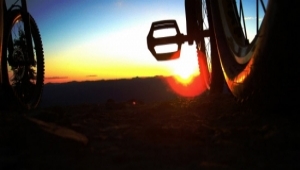Bike pedals
Whether it's a high line mountain trail or rolling down main street, the challenge of constantly churning the pedals has always helped people move forward in one way or another.

Bicycle pedals are best described as a platform on which the cranks of a bike are turned.
Attached by a spindle, pedals are allowed to rotate freely and be in constant contact with the rider's shoe, an interface with the bike that provides great control of speed and balance. The pedal is where power is initiated to the drive train of the bike. Ergonomics play a major part in the compatibility of a rider and their cycle, so having the proper pedals on a bike can make all the difference in a comfortable ride.
Every bike comes with pedals, even the cheapest of the cheap. So you can imagine the price range of what one might spend on a set of pedals. High-end pedals are made with carbon composites and titanium alloys that are specialized to fit the riding style and desired comfort of the rider. While some bike pedals can exceed $1,800 (for a set), a shopper could get an above-average set for under $100.
NOTE: Clipless pedals will need a pair of cycling shoes, which average at around $120 for a pair on amazon.com.
Right (drive) side pedals screw in clockwise, left (non-drive) side pedals screw in counterclockwise.

Removing and installing bike pedals is simple. If the cranks are secured with a nylon strap, the pedals can be unscrewed easily using a pedal wrench or on some cranks, a hex wrench. This will help unscrew the pedal correctly on either side without the cranks wanting to turn.
If you want to place the bike on a repair stand, the cranks can be turned in reverse on each side for removal, and forward for installation of new pedals.
Manufactured to fit the needs of every bicycle, pedals come in a few flavors. Track cycles need to be smooth, light and aerodynamic. Mountain bikes need to be versatile and rugged. One thing is for sure: a rider needs to have a comfortable grip on whatever they're riding on.
There are a few types of bike pedals:



Platform - Some riding styles such as BMX, mountain biking, or any winter commute in boots require more freedom of movement. With a wide open, flat design, metal studs are sufficient to grip the otherwise slippery platform pedals through the elements. In an effort to reduce weight, these pedals may come in a range of light and durable materials.



Quill - Similar to platform pedals, the more specialized quill design cuts back in bulk surface area. Mostly intended for track and road cycling, quill pedals save on weight and wind drag with a slender profile. Their skeleton forms spikes on the outside to keep the foot from sliding off during use. It's common to use a cage structure of plastic bindings or fabric straps to secure the shoe down.



Clipless - Attaching the pedal to the rider's shoe give better control over the bike, so unique shoes are made to fit exactly into brackets on clipless pedals. There is a variable degree of play in the cleats (called the "float") that allows movement making things easier on the rider's knees, before releasing the pedal. Avoiding the bulky straps and big frames, modern clipless designs have easy mount/dismount mechanisms and make a great lightweight option for competitive cycling athletes.
Pedals thread on differently on each side. On the right crank, the threading is right-handed (clockwise), while the left pedal on the non-drive side is threaded counter clockwise. This is to prevent the pedals from becoming loose during operation.
There are 2 main threading sizes: most pedals use 9/16 inch, but 1/2 inch is common for one-piece cranks.
NOTE: Old French cranksets use 14mm (.55 inch) threads, but they are extremely rare. These will start to thread on 9/16 cranks, but will bind before long. Be careful.
